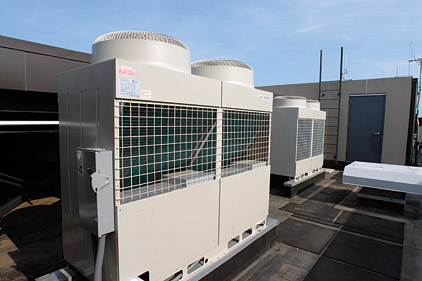It’s not just the HVAC industry that is taking notice of VRFs, though. The U.S. government’s General Services Administration (GSA), through the Green Proving Ground (GPG) program is looking at VRF technology in addition to other HVAC and energy management technologies.
According to the GSA’s website, the GPG “aims to drive innovation in environmental performance in federal buildings and help lead market transformation through deployment of new technologies.”
Besides the associations and agencies, are contractors giving attention to VRF? Many contractors are interested in the technology but have expressed that they would like to know more before getting involved with these systems. Others have already made that decision and have integrated VRFs into their customer offerings.
Background
According to the GSA’s website, a “VRF uses refrigerant as the cooling/heating medium, and allows one outdoor condensing unit to be connected to multiple indoor evaporators, each individually controllable by its user, while modulating the amount of refrigerant being sent to each evaporator. … By operating at varying speeds, VRF units work only at the needed rate. Heat recovery VRF technology allows individual indoor units to heat or cool as required, while the compressor load benefits from the internal heat recovery.”
A couple of other notable aspects of VRFs include that a VRF system’s indoor units can be used for cooling/heating a zone and the systems are most commonly installed in ductless applications. One of the reasons the GSA listed as to why “VRF technology holds particular promise for GSA’s historic buildings” is that “it enables the use of a large variety and configuration of inconspicuous indoor fan coil units.”
Other applications can run the gamut from residential to commercial. Martin Hoover, president of Empire Heating and Air in Decatur, Ga., said that his company installed them in sun rooms and attic expansions, but has installed them in computer rooms, too. Bill Murcko, new construction project manager, Blair’s Air Conditioning & Heating, Clearwater, Fla., said his company has installed them in residential houses ranging in size from 4,600-6,100 square feet. They are quite often found in commercial applications, too, such as university buildings and hotels.
What to Do and Not Do
One piece of advice that various contractors said they’d give to another contractor who has never worked with or on VRF equipment is to go get training and become certified, and follow the proper procedures. Brian McDonald, general manager of Outer Banks Heating & Cooling, Kill Devil Hills, N.C., put it even more simply. “Read the install manual,” he said.
Scott Getzschman, president of Getzschman Heating LLC, of Fremont, Neb., said that he believes that “if the contractors that install the [VRF] systems go through the certification process, you will see better results on service and installation practices.” He added that his company provides “continued training to all employees that would ever install or service these systems.”
Proper training makes a difference, Hoover indicated. He said the only problems his company has seen on VRF projects are “with improper installation procedures.”
Something else that Getzschman said is helpful to know about VRFs is that “they are similar to mini-splits in operation. Condensate is critical; make sure you can remove the condensate.”
Murcko said a critical component to the VRF installation process is “in regards to refrigerant piping and brazing, as well as flaring the refrigerant lines to the indoor units (braze at outdoor unit). The entire refrigerant piping circuit must be 100 percent free of leaks and pressure tested to 500-psi nitrogen. During brazing, nitrogen must be flowed through to avoid any contaminants inside the refrigerant lines.” He also advised HVAC contractors who have little or no experience with VRFs to “go out and buy a good set of flaring tools if you don’t already have one.”
Hoover said that when it comes to installing and servicing VRFs, one must not exceed line lengths or lifts (part of the manufacturer’s specifications for the maximum length and vertical lift of the copper lines separating the indoor unit from the outdoor unit) or fail to properly evacuate (air and moisture from the refrigerant piping).
Getzschman also remarked on line lengths. “There isn’t a problem as long as you can remove the condensate, and your line lengths fall within guidelines,” he said.
Another point that Murcko said contractors should know is “the duct systems (on ducted concealed mount units) are limited to an external static pressure of 0.47 w.c. in most cases (on high-static concealed). So long duct runs are prohibited, as well as higher MERV filters because their initial resistance in w.c. are so high.”
His biggest surprise when he began working on VRF projects “was how quickly and efficiently the inverter technology was able to initially cool down a house at start-up.”
Though proper training is needed and one must be mindful of such things as line lengths; refrigerant piping, brazing, and flaring; condensation removal; and proper evacuation; adding VRF systems to your company’s knowledge base gives you another solution your company can provide to solve customers’ comfort needs. Hoover said that in terms of his business, VRFs have “given us a new tool to work with, but hasn’t changed our overall makeup.”
For more information go to http://1.usa.gov/Tm0sl9
Publication date: 11/19/2012



Report Abusive Comment